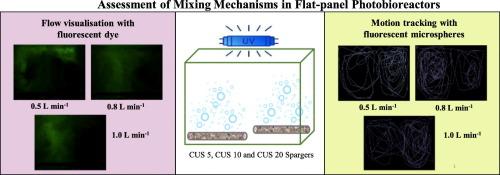Flow visualisation in flat panel photobioreactors with optimised gas spargers using fluorescent dyes and microspheres to evaluate mixing mechanisms and microalgae growth
Q1 Environmental Science
引用次数: 0
Abstract
Flat-panel photobioreactors (PBRs) are widely used for microalgae cultivation due to their high surface-area-to-volume ratio, efficient light distribution, and scalability. However, their efficiency is limited by suboptimal gas–liquid mixing and mass transfer, often caused by ineffective spargers. This study investigates flow patterns in a 10 L flat-panel PBR using optimised spargers that generate micro-size bubbles, aiming to improve mixing. Continuous and intermittent airflow conditions were tested at 0.5, 0.8, and 1 L min−1. Two qualitative flow visualisations, fluorescent dye imaging and motion tracking with fluorescent microspheres, were employed. Flow pattern images were captured using a high-speed camera, while a UV lamp was used to illuminate the fluorescent dye and particles, enhancing visualisation for detailed image analysis. Results confirmed that the sintered metal sparger (5 μm pores), arranged in a novel double orientation with 1 L min−1, provided optimal mixing, which was validated biologically as the most suitable configuration for Chlorella sorokiniana cultivation. Intermittent airflow (20 s ON, 10 s OFF) provided adequate culture mixing with 33 % lower energy. It resulted in improved Chlorella sorokiniana performance, yielding a higher specific growth rate (0.56 d−1), shorter doubling time (1.24 days), greater biomass productivity (0.12 g L−1 d−1), and CO₂ fixation (0.21 g L−1 d−1) compared to continuous flow. This research advances the understanding of micro-mixing in PBRs and evaluates sparger designs for improved microalgae cultivation and carbon capture. Future studies should integrate computational fluid dynamics to validate the findings. The underlying mechanisms will contribute to developing sustainable and efficient PBRs for CO2 sequestration and bioresource production in circular economy applications.

利用荧光染料和微球对优化气体喷射器的平板光生物反应器进行流动可视化,以评估混合机制和微藻生长
平板光生物反应器(pbr)因其高表面积体积比、高效配光和可扩展性而被广泛应用于微藻培养。然而,它们的效率受到气液混合和传质不理想的限制,这通常是由无效的喷雾器引起的。本研究研究了10 L平板PBR中的流动模式,使用优化的喷射器产生微尺寸气泡,旨在改善混合。在0.5、0.8和1 L min - 1下测试连续和间歇气流条件。采用荧光染料成像和荧光微球运动跟踪两种定性流动可视化技术。流动模式图像是用高速摄像机拍摄的,而紫外线灯则用来照亮荧光染料和颗粒,增强了详细图像分析的可视化效果。结果表明,以1 L min−1的双取向排列的烧结金属分散孔(5 μm)提供了最佳的混合,生物学上验证了这是最适合小球藻培养的配置。间歇气流(开20秒,关10秒)提供充分的培养混合,能量降低33%。结果表明,与连续流动相比,小球藻的特定生长率更高(0.56 d−1),倍增时间更短(1.24 d),生物量生产力更高(0.12 g L−1 d−1),CO 2固结率更高(0.21 g L−1 d−1)。本研究促进了对pbr中微混合的理解,并评估了用于改进微藻培养和碳捕获的分散器设计。未来的研究应结合计算流体动力学来验证这些发现。其基本机制将有助于开发可持续和有效的pbr,用于二氧化碳封存和循环经济应用中的生物资源生产。
本文章由计算机程序翻译,如有差异,请以英文原文为准。
求助全文
约1分钟内获得全文
求助全文
来源期刊

Bioresource Technology Reports
Environmental Science-Environmental Engineering
CiteScore
7.20
自引率
0.00%
发文量
390
审稿时长
28 days
 求助内容:
求助内容: 应助结果提醒方式:
应助结果提醒方式:


